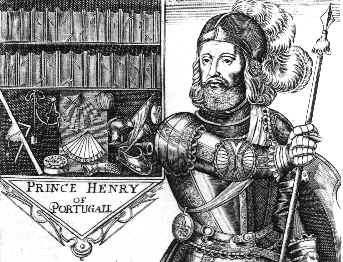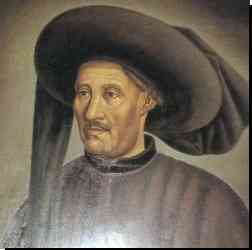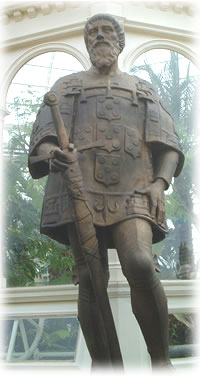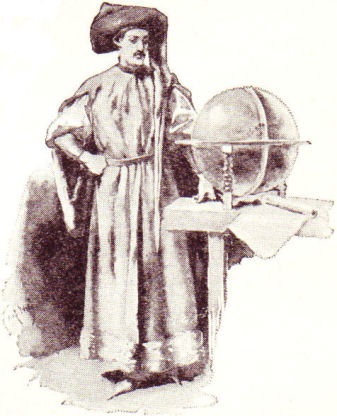Henry the Navigator Inaugurates the Age of Discovery
by Jeremias Wells
At the beginning of the fifteenth century, Europe lived in splendid isolation. The existence of North and South America, sub-Saharan Africa and the islands off the coast of southeastern Asia was completely unknown in Europe. Moreover, since the Arabs controlled the Red and Arabian Seas and the Holy Land, and the Turks had crossed over the Dardanelles and were moving through the Balkans, all major commercial routes from the Orient terminated in Moslem lands, adding to Christian isolation and marginalization. The Venetian and Genoese merchantmen plying the Mediterranean had to deal with the Moslems on their terms, which required a certain amount of ethical compromise.

Henry the Navigator in the Battle of Ceuta. Infante Henry was 21 when he, his father and brothers captured the Moorish port of Ceuta in northern Morocco, that had long been a base for Barbary pirates who raided the Portuguese coast, depopulating villages by capturing their inhabitants to be sold in the African slave market. Photo by Beria
However, in a moment of seeming peril, the vibrant, self-generating Christian Civilization burst forth once again and rose to the point where 250 years later it dominated the world. The catalyst for this resurgence was spearheaded by Portuguese shipbuilders and sailors, Spanish sea captains, Italian navigators and an austere, devout prince from the Portuguese royal family. The field of world exploration opened up for Christianity when the Arabs, who had pioneered in sailing techniques became indifferent to further sea expansion and the Chinese, who had controlled oriental shipping retreated behind their famous walls and ignored the outside world. European resourcefulness, courage and determination brought about the Age of Discovery, especially the adventurous spirit of chivalry inherent in its originator, Prince Henry the Navigator of Portugal.
Henry the Navigator
John I founded the Aviz dynasty by seizing the Portuguese throne in 1385. Later in the year, with the help of English archers, he secured his independence from Castilian meddling by defeating them at the decisive Battle of Aljubarrota and as a result married the daughter of John of Gaunt, Duke of Lancaster. Of the six children of King John and Queen Philippa that survived infancy, Henry was the third son. The family enjoyed a unity—rare among European courts—based on mutual affection, piety, intellectual distinction and chivalry. At Henry’s birth, the Queen appropriately dedicated him to King Louis IX of France, for the principles that guided the royal saint permeated the entire Aviz family. The resemblance did not end there for Philippa, granddaughter of Edward III of England, brought a strong moral rectitude to court life, as did Louis’ mother Blanche of Castile.
 The enthusiasm for things military and religious at the Portuguese court molded the chivalric spirit of the three oldest boys when they were reaching their late teens. When in 1412 King John suggested a yearlong series of tournaments to provide an opportunity for the young princes to win their knighthood, they ridiculed such phony warfare and advocated the real thing, to which their father reluctantly agreed. They chose as their target the large Moslem stronghold and trading center of Ceuta (pron. Soo’ta), located on the North African coast opposite Gibraltar. To Portuguese eyes and especially young Henry, only eighteen at the beginning of the preparations, the battle would continue the Reconquest, for the Pope had granted the spiritual benefits given to Crusaders to all those who militarily resisted the ongoing Moslem encroachment. Since Henry despite his age was the driving force for the venture because of his resolute, chivalric nature, the bulk of the military organization and shipbuilding fell upon his shoulders.
The enthusiasm for things military and religious at the Portuguese court molded the chivalric spirit of the three oldest boys when they were reaching their late teens. When in 1412 King John suggested a yearlong series of tournaments to provide an opportunity for the young princes to win their knighthood, they ridiculed such phony warfare and advocated the real thing, to which their father reluctantly agreed. They chose as their target the large Moslem stronghold and trading center of Ceuta (pron. Soo’ta), located on the North African coast opposite Gibraltar. To Portuguese eyes and especially young Henry, only eighteen at the beginning of the preparations, the battle would continue the Reconquest, for the Pope had granted the spiritual benefits given to Crusaders to all those who militarily resisted the ongoing Moslem encroachment. Since Henry despite his age was the driving force for the venture because of his resolute, chivalric nature, the bulk of the military organization and shipbuilding fell upon his shoulders.
In the summer of 1415, over 200 ships, including 63 transports carrying 20,000 men-at-arms and 30,000 sailors cruised into the Mediterranean. At first light on August 24, the Portuguese army landed on the beach outside the walled city and minutes later the vanguard led by Prince Henry hacked its way into the city to be followed by the main force. With Henry always in the forefront, the well-prepared army easily subdued the Moors and by dusk the Portuguese flag was flying over the citadel. The conspicuous bravery of the young Crusader so impressed the King that he wanted to knight him first, but he refused saying that it would be unjust to his older brothers who also fought bravely.
After a second, successful relief expedition to Ceuta, Henry received offers from the Pope, Emperor and several kings to take command of an army against the infidels because of his military prowess and astuteness. However, although the spirit of chivalry still burned intensely in his soul, his North African experiences had bred in him a driving desire to explore the coast of Africa, find a sea route to the Orient that would outflank the Moslems and in so doing convert the heathen and find adventure and riches. Henry spent several months in Morocco gathering information about the caravan routes through the interior with their cargoes of gold, ivory and spices, about the Berbers who lived on the desert fringe and about the Blacks who lived in the green jungles.
Grand Master, Knights of Christ
 When Henry returned to Portugal, he did not go back to the court, but made his headquarters on a wind-swept promontory on the extreme southwest corner of Portugal (and also of Europe) overlooking the mysterious, endless, invigorating Atlantic Ocean. There at Sagres the chivalrous ascetic established a villa that was half monastery and half school for explorers and cartographers, reflecting his dual nature of piety and adventure.
When Henry returned to Portugal, he did not go back to the court, but made his headquarters on a wind-swept promontory on the extreme southwest corner of Portugal (and also of Europe) overlooking the mysterious, endless, invigorating Atlantic Ocean. There at Sagres the chivalrous ascetic established a villa that was half monastery and half school for explorers and cartographers, reflecting his dual nature of piety and adventure.
This combination of religious fervor and courageous exploration reached its ultimate expression when his father named him Grand Master of the Order of the Knights of Christ. When the Knights Templars were suppressed in 1312 through mostly spurious charges, they were completely exonerated in Portugal by the Bishop of Lisbon. Because of their exceptional military value in a small nation of about three million people, the Templars were reorganized into the Knights of Christ and received from Pope John XXII the Rule of Saint Benedict and the constitution of Citeaux. Henry took his obligations with the utmost seriousness and utilized the wealth of the Order and subsequent riches to build new ships to facilitate his grand vision.
Coasting Northwest Africa

The caravel was developed in about 1450, based on existing fishing boats under the sponsorship of Prince Henry the Navigator of Portugal and soon became the preferred vessel for Portuguese explorers.
The first few years of Henry’s seafaring enterprise produced very little except the rediscovery of the Madera Islands because the superstitious sailors absolutely refused to go beyond a slight outcrop of land on the West African coast called Bojador. Courageous in battle, capable of enduring long hours of toil and accepting a life of privation, these rugged seamen trembled at the thought of sea monsters, a boiling sea, a blackening sun, the ocean running downhill and other irrational dangers they would face by sailing past that point.
Finally in 1434, Henry using his commanding personality pressured a young, capable captain, Gil Eannes, to manfully pass the dreaded cape after a previous failure of nerve. As the apprehensive captain approached the latitude of Bojador, he swung westward out to sea and them circled back to the coastline well south of the cape. The psychological barrier had been shattered. The following year, Eannes sailed another eighty miles past Bojador and found human and camel footprints in the sand, first evidence of other men living south of the Moroccan Moors. One more voyage ninety miles farther down the coast, achieved some modest success before Henry requisitioned all available ships for an ill-fated attack on Tangier on the Atlantic coast of Morocco.
Tangier and Blessed Fernando
The capture of Tangier, always an objective of the strategically minded Prince, could give the Portuguese a forty-mile stretch of land west of Ceuta from which to launch other attacks. Henry, now accompanied by his younger brother Fernando, much like himself in piety and crusading spirit, most likely had in mind the great victory won by the royal family twenty-two years before, but apparently he forgot everything else. That overwhelming success was achieved by careful planning, sufficient numbers of men along with other resources, and a clever ruse that concealed their objective, none of which was present in 1437.
The inadequate army marched overland from Ceuta while the navy, mostly trading vessels, carried the supplies along the coast. The first three assaults on the walls failed, and as thousands of Moslem reinforcements arrived, the Christians found themselves surrounded and cut off from their supply ships. The few thousand Christians fought against tens of thousands of Moors with indomitable courage. Wave after wave charged against the Portuguese leaving behind mounds of Moslem dead. Seeing that the cost of annihilating the doomed Christians would increase the death total to staggering heights, the Moroccan King offered terms of peace. Prince Henry and his men would be allowed safe passage to their ships, but they would have to surrender the city of Ceuta to which they agreed. Prince Fernando and the Moroccan King’s son were exchanged as hostages to ensure compliance. But as they began their retreat, the wild Berber tribesmen broke the treaty by attacking the Christians who had to fight their way back to the ships. Henry’s last memory of his beloved brother was to watch him and several of his faithful servants ride into captivity from which he would never return.
During his youth Fernando lived a life of eminent sanctity, reciting the Daily Office and fasting regularly, and spent much of his time alleviating the sufferings of the poor. In keeping with the family’s crusading heritage, his brother King Edward (John I died in 1433) installed him Grand Master of the Knights of Aviz, a religious military order associated with the Spanish Knights of Calatrava through the Cistercian Rule.
The only terms that the Moors would accept for his release was the surrender of Ceuta, and that the Christian community from the Pope on down refused. As a consequence the Moslems treated him with the utmost severity for the six years remaining to him. At first they condemned him to a dark dungeon and then forced him to work as a slave in the stables. When weakness and dysentery made him unfit for work, his vengeful jailers sent him back once again to the dungeon to spend his final days lying on a stone floor in darkness and solitude, absorbed in prayer and love for Our Lady for which she blessed him with a visit before he died. He was beatified by Pope Paul II in 1470.
The Caravel

Padrão dos Descobrimentos. Monument to the Portuguese maritime discoveries in Lisbon. This monument commemorates 500 years since the death of Prince Henry the Navigator and honors 15th and 16th century Portuguese explorers.
One year after Tangier (1438) King Edward (Duarte I) died, broken by the crushing defeat and the imprisonment of his youngest brother. Through Henry’s mediation the second brother, Pedro, took over the reins of government as regent for his six-year-old nephew, the eventual Alfonso V, after which the determined explorer returned to Sagres to resume his career as the architect of the Age of Discovery.
As Henry’s seafarers were exploring farther south than Europeans had ever gone before, he had to improve on methods of navigation, cartography and shipbuilding. His community of creative innovators at Sagres helped make the quadrant, new mathematic tables and other instruments that allowed for more precision in determining latitude. This and Henry’s requirement that captains keep accurate logbooks and charts greatly improved the science of mapmaking.
However, the necessity of coasting in shallow waters and returning to Portugal against the prevailing North wind produced the most novel innovation: the caravel. The first Portuguese explorations took place in typical Mediterranean, oared galleys with a single sail or barks with square rigging. The earlier caravels carried two large, triangular, lateen sails rigged fore-and-aft, although later in the century a third mast was added. This allowed for greater maneuverability, ease of handling and smaller crews of about 20. The stern was built up with a poop deck and an after castle, but no superstructure forward. The first coasters ran about 80 feet in length, 25 feet in the beam and had a draught of about 5 feet. The ruggedness of the seafarers is illustrated in their onboard life. The caravel provided no sleeping accommodations except for a cabin on the quarterdeck and a bunk or two in the steerage. Most of the crew had to sleep on deck or in bad weather on top of the cargo and cooking facilities were simply not available. Their diet consisted of biscuits and dried fish.

Relentlessly the caravels passed further and further down the West African coast from the barren desert where they encountered Tuareg tribes, to more fertile country marked by the Senegal River, where they found African Blacks. They began to bring back captives to work as domestic servants in an underpopulated country. Slavery was as commonplace in the fifteenth century as it is considered objectionable in the twenty-first: All the oared galleys in the Mediterranean, both Christian and Moslem, were manned by captives from the other side. But Henry was chiefly motivated by converting the heathen to Christianity and that was accomplished on a large scale. They were treated with kindness and decency. Some were adopted by their masters and made heirs; others married Portuguese and their offspring were born free; while still others were granted freedom after some years. In time their bloodline was completely integrated.
The Portuguese Begin to Dominate
As the Portuguese increased their control over the area, the whole coastline from Cape Blanco to Cape Verde rose up against the white invaders. A fleet of twenty-six ships sailed from Lagos and Lisbon to pacify what was then known of the coast of Guinea. They built a fort on Arguim Island, the first of many forts and trading posts built along the route from Africa to India to the Spice Islands (the Moluccas) off Southeast Asia. After that Henry’s captains established friendly relations with the local chieftains and made contact with traders from the Kingdom of Mali and the caravan trading center of Timbuktu. Henry dispatched a priest to one of the tribes at the request of the chief.
Henry petitioned His Holiness to concede all new territory beyond Cape Bojador to the Portuguese crown and asked that the Order of Christ have spiritual jurisdiction over all converts. He further requested that those who died on the voyages of exploration be granted a Crusader’s indulgence. Pope Eugenius IV, overjoyed with the maritime success on the western flank of Moslem power, granted all his requests in a Papal Bull.
At the time of his death in 1460, Henry had set in motion a process of continuous exploration that was driven not by any outside force but by his own endurance, constancy and most of all his vision.
Many other explorers became more famous, but they built on the success of a royal prince who lived as close to the sufferings of Christ as he was capable.
___________________________
Bibliographical note:
The biographies that we chose for Prince Henry were: Ernle Bradford, Wind from the North (New York, 1960), Elaine Sanceau, Henry the Navigator (New York, 1947).
Short Stories on Honor, Chivalry, and the World of Nobility—no. 229








